All Science Fair Projects
1000 science fair projects with complete instructions, explosive elephant toothpaste.
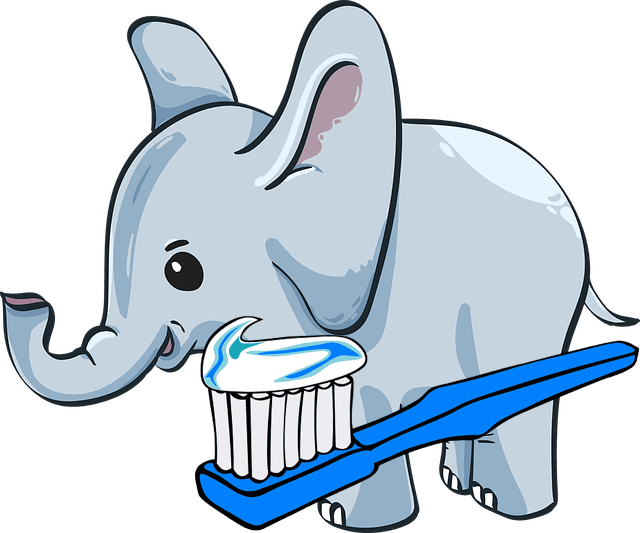

Method & Materials
Why do this project, also consider, full project details, related videos.
Related Science Fair Project Ideas
- Grades 6-12
- School Leaders
Win Daily Prizes in Our Very Merry Holiday Giveaway! 🎁
Elephant Toothpaste Experiment: How-To Plus Free Worksheet
Heat things up with this larger-than-life science lesson.

Who knew toothpaste could be so fun? While no actual toothpaste is produced, this experiment is an exciting and hands-on way to bring several science lessons to life. You’ll want to use some caution when performing it with kids. Some of the chemicals used can be irritating and the substance produced is hot, so you won’t want to actually brush anyone’s teeth with the foam, as tempting as that may be! Read on to see how to do the Elephant Toothpaste Experiment, and fill out the form on this page to grab your free recording sheet.
How does the Elephant Toothpaste Experiment work?
This experiment works through a chemical reaction that results from a catalyst (potassium iodide, aka yeast) being introduced into a mixture of hydrogen peroxide and dish soap. The hydrogen peroxide is decomposed into water and oxygen and the catalyst speeds up the reaction, forcing the oxygen into the soap bubbles. The resulting effect is the substance quickly pouring up and out of the container.
What does the Elephant Toothpaste Experiment teach?
This experiment is a crowd-pleaser, but it also serves to teach kids a lot. The concept of a catalyst speeding up a reaction is demonstrated in an obvious and exciting way as the introduction of the yeast forces the foam to explode up and out of the bottle. It also teaches kids about exothermic reactions as the foam coming out of the bottle is hot. Additionally, kids get to see a decomposition reaction as the rapid decomposition of hydrogen peroxide results in the release of oxygen gas.
Is there an Elephant Toothpaste Experiment video?
This video from teacher Hilary Statum will give you the step-by-step instructions for making your own Elephant Toothpaste.
Materials Needed
To do the experiment, you will need:
- 16-oz. empty plastic soda bottle
- Very warm water
- 3% hydrogen peroxide (6% is better, if available)
- Measuring cups
- Measuring spoons
- Safety glasses
- Safety gloves
- Funnel or measuring cup with a lip
- Food coloring
Our free recording sheet is also helpful— fill out the form on this page to get it!
Elephant Toothpaste Experiment steps:
1. place the bottle on a large tray and put on your safety goggles and gloves., 2. mix 1 tablespoon of yeast into 3 tablespoons of warm water until you achieve a creamy consistency. place in a small cup and set to the side., 3. use a funnel or measuring cup to pour half a cup of hydrogen peroxide into the bottle., 4. add a bit of food coloring. for a solid color, add directly into the bottle. for stripes, squirt it with the pipettes so it trickles down the sides of the inside of the bottle., 5. add approximately 1 tablespoon of dish soap to the hydrogen peroxide., 6. use a funnel or measuring cup to add the yeast mixture to the bottle., 7. step back and watch the explosion, grab our free elephant toothpaste experiment worksheet.

Fill out the form on this page to get your worksheets. The first worksheet asks kids to make a prediction about what they think will happen. They can use the provided spaces to draw or write their predictions and observations. The second worksheet lists questions for students to answer about the experiment.
Additional Reflection Questions

- Why do we add the yeast to the water?
- What do you think would happen if we added more dish soap?
- What do you think would happen if we added more yeast to the mixture?
- What is the liquid that is left in the bottle?
- Describe the reaction that occurs. How long does it last?
Can this experiment be done for a science fair?
Yes! If you want to do the Elephant Toothpaste Experiment for a science fair, we recommend switching up some of the variables. For example: Does the type or shape of the container matter? Does the type of dish soap matter? Does adding more yeast change the reaction? Form a hypothesis about how changing the variables will impact the experiment. Good luck!
Looking for more experiment ideas? Check out our big list of experiment ideas here.
Plus, be sure to subscribe to our newsletters for more articles like this., you might also like.

Egg and Vinegar Experiment: How-To Plus Free Worksheet
It's so easy you'll want to do it again and again. Continue Reading
Copyright © 2024. All rights reserved. 5335 Gate Parkway, Jacksonville, FL 32256
Cool Science Experiments Headquarters
Making Science Fun, Easy to Teach and Exciting to Learn!
Science Experiments
Elephant Toothpaste Science Experiment
Elephant Toothpaste anyone? Although elephants might not be too excited about the idea, your kids will be thrilled with the fun chemical reaction of this super simple science experiment.
With only a few common items that you probably already have at home, kids can see the quick and impressive results of the chemical reaction, feel the heat released from the process, and even play with the “elephant toothpaste” foam afterward.
Below you’ll find detailed and printable instructions, a materials list, a demonstration video, and an easy to understand explanation of why it works!
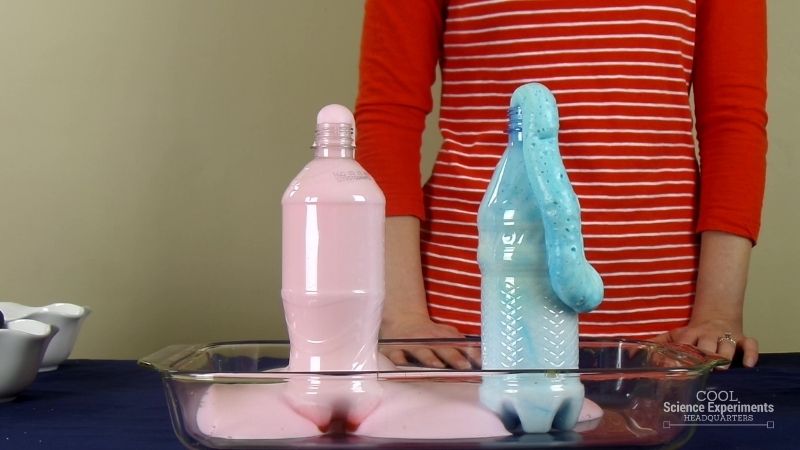
JUMP TO SECTION: Instructions | Video Tutorial | How it Works
Supplies Needed
- 2 Tablespoons Warm Water
- 1 Teaspoon Yeast
- Food Coloring
- Hydrogen Peroxide – Either 3% or 6%
- Empty Plastic Bottle
Helpful Tip: You can find the 3% at most stores, but you will need to either go to a Beauty Supply Store or order the 6% online. In the video I perform the experiment two ways. Once using the 3% peroxide and once using the 6%. It is often recommended to use 6% peroxide, but we actually preferred the reaction that happened with the 3% better.
Elephant Toothpaste Science Lab Kit – Only $5
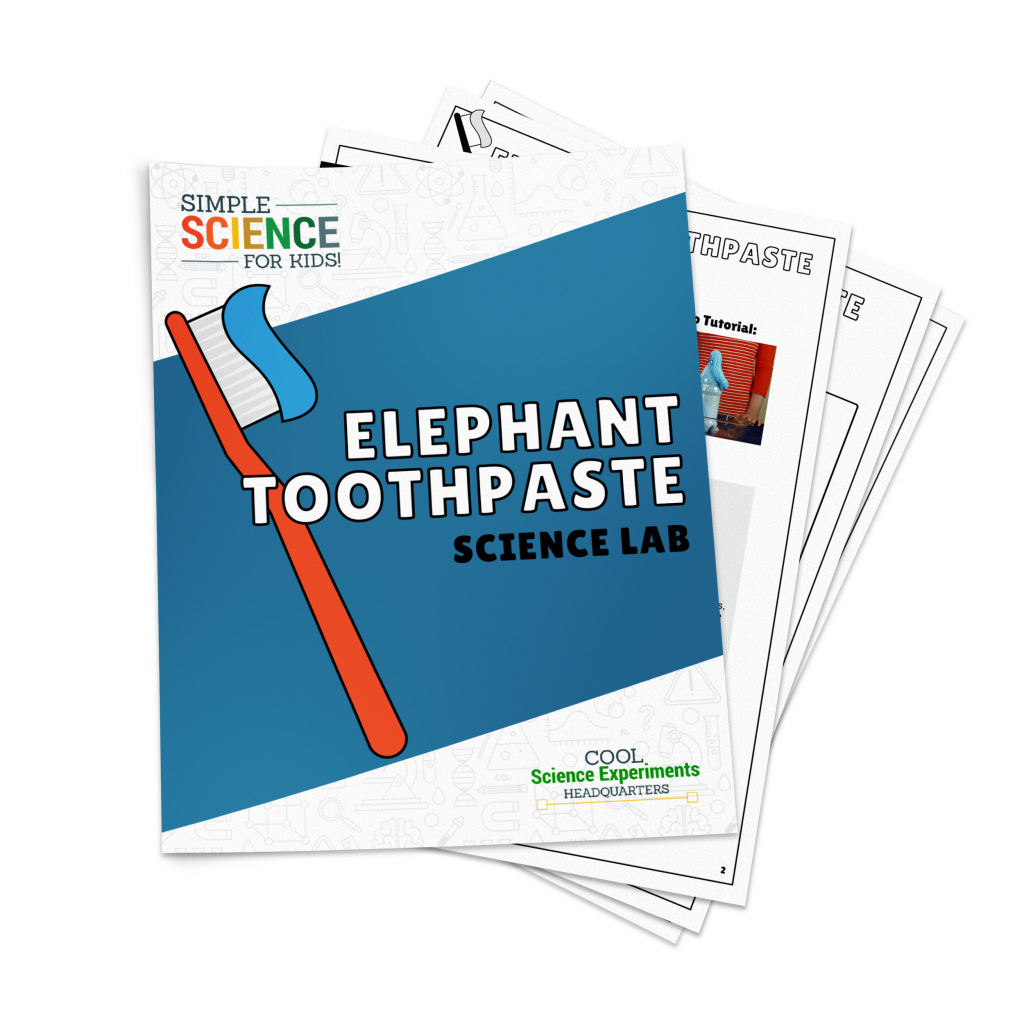
Use our easy Elephant Toothpaste Science Lab Kit to grab your students’ attention without the stress of planning!
It’s everything you need to make science easy for teachers and fun for students — using inexpensive materials you probably already have in your storage closet!
Elephant Toothpaste Experiment Instructions
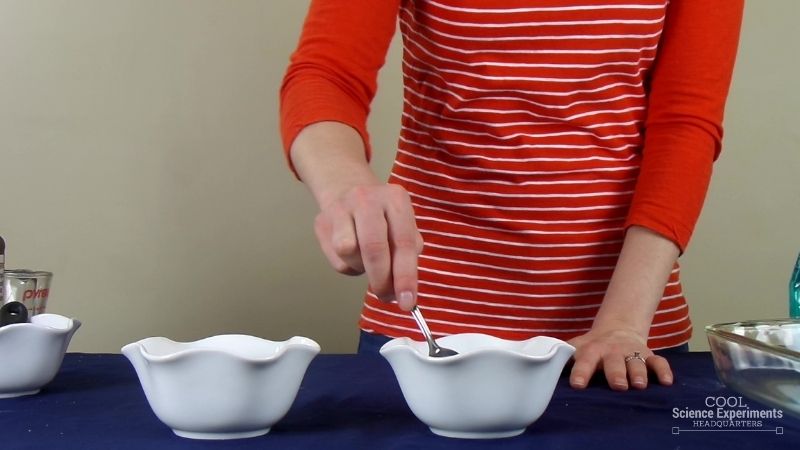
Step 1 – Combine two tablespoons of warm water with one teaspoon of yeast and mix until the yeast is completely dissolved in the water.
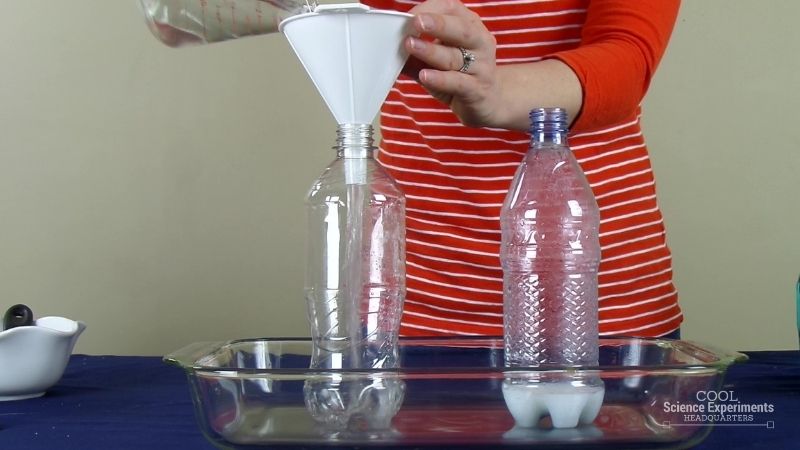
Step 2 – Pour 1/2 cup hydrogen peroxide into the empty bottle. You’ll see here that we have two bottles. The bottle pictured on the left is being filled with 3% hydrogen peroxide while the bottle pictured on the right is filled with 6% hydrogen peroxide.
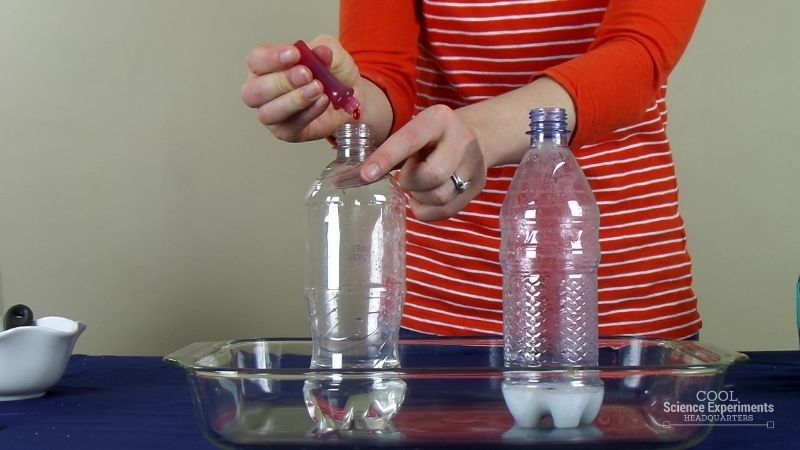
Step 3 – Add a few drops of food coloring into the bottle. Take a moment to make a few observations. What happened when you added the drops of food coloring?
Note: This step is optional, but adding the color adds a fun element to the experiment. You’ll see that we used a different color of food coloring for each bottle.
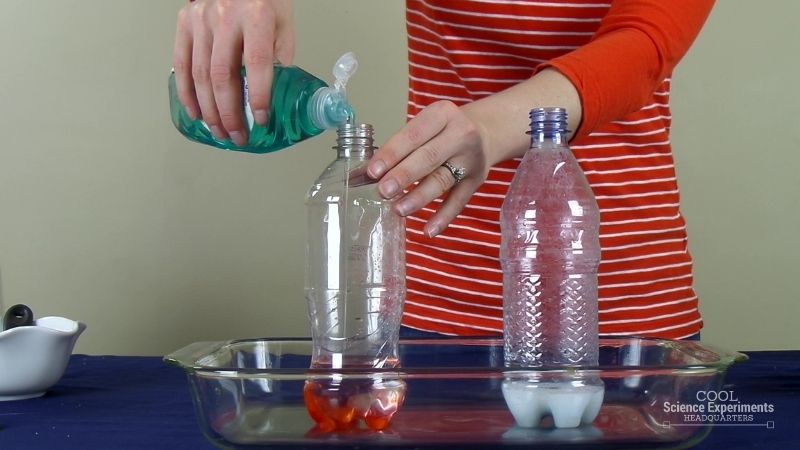
Step 4 – Next, add a squirt of dish soap into the bottle. Again, take a moment observe what happened. Did adding the dish soap appear to have any effect on the liquid already in the bottle?
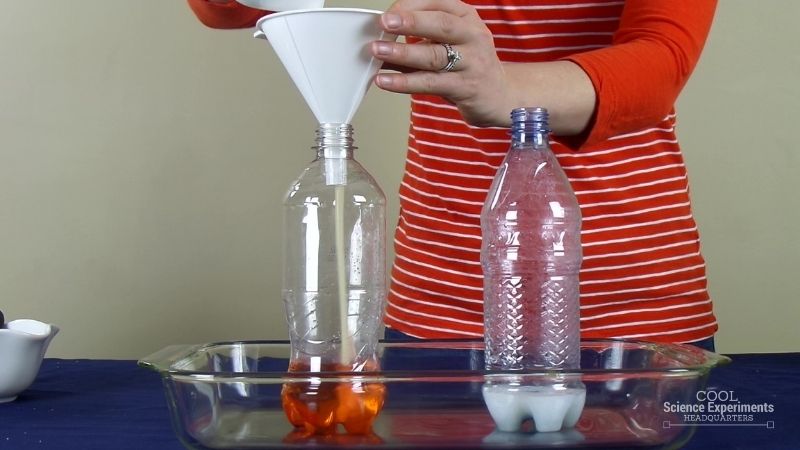
Step 5 – Finally, pour the mixture of water and yeast into the bottle. Watch carefully and observe what happens.
Helpful Tip: You may need to gently swirl the bottle in order to get the items to completely combine. We had to do that for the 6% hydrogen peroxide.
Sit back and watch what happens. Write down your observations as you watch the experiment. Can you describe what happens when you add the water and yeast mixture to the bottle. If you are using both the 3% and the 6% hydrogen peroxide like we are, is there a difference between what happens?
Wondering what caused the liquid to react that way? Find out the answer in the how does this experiment work section below.
Video Tutorial
Watch the Elephant Toothpaste Science Experiment Step by Step Instructions Video
How Does the Elephant Toothpaste Science Experiment Work
This experiment shows a very impressive and fast chemical reaction! Hydrogen peroxide is a combination of hydrogen and oxygen (H2O2). In this experiment, yeast is a catalyst that helps release oxygen molecules from the hydrogen peroxide solution.
A catalyst is a material that increases the rate of a reaction without itself being consumed
The release of oxygen molecules in this experiment happens FAST! The foam created in this chemical reaction is made up of very tiny oxygen bubbles. These bubbles result when hydrogen peroxide (H2O2) is broken down by the yeast into water (H2O) and oxygen (O2).
During the reaction, feel the bottle. It will feel warm to the touch because it is an exothermic reaction .
An exothermic reaction is a chemical reaction that releases energy through light or heat (in this case, heat).
The reaction will continue and foam will be produced until all of the hydrogen peroxide (H2O2) has been broken down into water (H2O) and oxygen (O2).
**Have fun playing with the foam after the experiment is over! It is safe to touch because all that foam is just soap, water and oxygen. Let your kids have some fun with the foam too. Just be sure to have a towel handy!
Other Ideas to Try
Try adding more or less yeast when doing the experiment again. How does this affect the amount of foam produced?
Try the experiment again, but change the size of the bottle. How does this affect the amount of foam produced?
I hope you enjoyed the experiment. Here are some printable instructions:
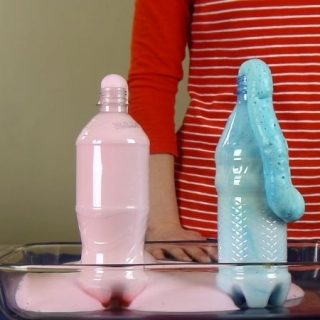
- Hydrogen Peroxide – Either 3% or 6%
Instructions
- Combine two tablespoons of warm water with one teaspoon of yeast and mix until the yeast is completely dissolved in the water.
- Pour 1/2 cup hydrogen peroxide into the empty bottle
- Add a few drops of food coloring into the bottle
- Add a squirt of dish soap into the bottle
- Pour the mixture of water & yeast into the bottle
- Sit back and watch what happens

Reader Interactions
February 7, 2016 at 8:13 pm
do it was a cemical reacin
February 8, 2016 at 1:15 pm
Correct! The yeast is mixed with the hydrogen peroxide causes a chemical reaction.
Which version did you like better, the one that reacted fast or the one that reacted slow?
May 17, 2018 at 12:31 pm
Looks amazing! What is the chemical reaction?
March 24, 2019 at 10:40 am
I’m am going to do that science project and this was super helpful thanks so much
March 24, 2019 at 10:46 am
Thank you so much I am doing this science project and I don’t know what to do and now I know what to do j
September 1, 2019 at 8:09 am
Did you try using more yeast or more 3 % hydrogen peroxide?
Found this explanation: “The yeast acted as a catalyst; a catalyst is used to speed up a reaction. It quickly broke apart the oxygen from the hydrogen peroxide. Because it did this very fast, it created lots and lots of bubbles. Did you notice the bottle got warm. Your experiment created a reaction called an Exothermic Reaction – that means it not only created foam, it created heat! The foam produced is just water, soap, and oxygen ” The yeast is not reacting with the hydrogen peroxide. Rather it is acting as a catalyst. A catalyst is a substance that causes a chemical reaction to speed up but is not “used” up during the reaction. Hydrogen Peroxide: H2O2 hydrogen and oxygen Baker’s Yeast: C19H14O2 carbon, hydrogen and oxygen
August 18, 2020 at 2:25 pm
My son did this experiment which was great! The only problem was that he played with the foam afterwards and his hands got super itchy. Can you be allergic to the yeast? Just a warning in case this happens to anyone else.
August 11, 2023 at 8:49 pm
Yeah I did this with potassium iodide and 25% hydrogen peroxide in a lab and my fingers went a little white on the tips (I had gloves on after this happened) they did get itchy and I think it was just the hydrogen peroxide bleaching the skin. This is an exothermic reaction so it can get hot not sure how hot with yeast.
January 25, 2022 at 11:25 am
It did not work for me and i don’t know why maybe caused i used rubbing alcohol insted
December 6, 2023 at 3:55 pm
good helpful and fun
Leave a Reply Cancel reply
Your email address will not be published. Required fields are marked *
Save my name, email, and website in this browser for the next time I comment.

- Privacy Policy
- Disclosure Policy
Copyright © 2024 · Cool Science Experiments HQ

- Science Notes Posts
- Contact Science Notes
- Todd Helmenstine Biography
- Anne Helmenstine Biography
- Free Printable Periodic Tables (PDF and PNG)
- Periodic Table Wallpapers
- Interactive Periodic Table
- Periodic Table Posters
- Science Experiments for Kids
- How to Grow Crystals
- Chemistry Projects
- Fire and Flames Projects
- Holiday Science
- Chemistry Problems With Answers
- Physics Problems
- Unit Conversion Example Problems
- Chemistry Worksheets
- Biology Worksheets
- Periodic Table Worksheets
- Physical Science Worksheets
- Science Lab Worksheets
- My Amazon Books
Elephant Toothpaste – Two Ways to Make It

Elephant toothpaste is a chemical reaction that makes a volcano of foam when soapy water traps gases from the rapid decomposition of hydrogen peroxide. There are two easy methods for making elephant toothpaste. One makes a giant mountain of foam, while the other produces a smaller effect but is safe enough for kids to touch. The dramatic reaction uses strong peroxide and potassium iodide, while the kid-friendly version uses dilute peroxide and replaces potassium iodide with yeast. Here are instructions for both methods and a look at the chemistry involved.
Why Is It Called Elephant Toothpaste?
First, you may wonder why the reaction has the name “elephant toothpaste.” It’s because the thick column of foam escaping a tube looks like toothpaste big enough for an elephant to use. Also, it’s a lot easier and more descriptive than calling the reaction “rapid decomposition of peroxide”. After all, the point of elephant toothpaste is engaging people in the wonder of science. Even if someone doesn’t understand the chemistry, the project is fun and entertaining.
How to Make Giant Elephant Toothpaste
When you see videos of the world’s largest elephant toothpaste, you’re viewing the classic version of the demonstration.
This version uses concentrated hydrogen peroxide, potassium iodide or sodium iodide, liquid dishwashing detergent, water, and (if desired) food coloring:
- 30% hydrogen peroxide (H 2 O 2 )
- Potassium iodide (KI) or sodium iodide (NaI)
- Liquid dishwashing detergent
- Food coloring (optional)
- Large graduated cylinder or Erlenmeyer flask
- Tray or tarp to catch the foam
The chemicals are available online, although it’s easier to just pick up the peroxide at a beauty supply store. Choose any tall container for the demonstration, but use glass and not plastic because the reaction generates heat.
Start by putting on proper safety gear, including safety goggles and gloves.
- First, prepare a saturated solution of potassium iodide or sodium iodide in water. In a beaker, dissolve crystals of either chemical in about 120 ml (4 ounces) of water. Continue stirring in the solid until no more dissolves. It takes about a tablespoon of the dry chemical. But, measurements are not critical here. Set aside the solution for now.
- Set the cylinder or flask in a tray or on a tarp. Pour about 60 ml (2 ounces) of 30% hydrogen peroxide into the glass tube. Add a squirt (about 5 ml) of dishwashing liquid to the tube. If you want colored foam, add a few drops of food coloring. Swirl the liquids to mix them. Here again, exact measurements are unnecessary.
- When you’re ready for the reaction, pour about 15 ml (one tablespoon) of the iodide solution and stand back. Foam forms within seconds and rapidly escapes the tube.
- After the reaction ends, wash the contents of the tray and tube down the drain with water.
Kid-Friendly Elephant Toothpaste
The classic chemistry demonstration is for chemistry educators, but the kid-friendly elephant toothpaste is safe enough for parents and children to perform and touch. Also, this version uses easy-to-find ingredients.
- 3% household peroxide
- 1-2 packet of dry yeast
- Food coloring
- Empty plastic soft drink bottle
- Cookie sheet or pan to catch the foam (optional)
It’s not necessary to don safety gear for this reaction and it’s fine to use either a plastic or glass container. Just make sure the bottle has a narrow opening because this channels the foam and improves the effect.
Don’t worry about measuring ingredients precisely.
- Pour about a cup of 3% hydrogen peroxide into an empty bottle. If the bottle opening is small, use a funnel.
- Add a couple of squirts of dishwashing liquid and a few drops of food coloring to the bottle. Swish the liquid around to mix it.
- In a separate container, mix together yeast with enough warm water that the liquid is easy to pour. A paper cup is a great container choice because you can pinch its rim and make pouring the yeast mixture easier. Wait a couple of minutes before proceeding so the yeast has a chance to activate.
- When you’re ready, place the bottle on a cookie sheet or pan and pour yeast mixture into the bottle
- Clean-up using warm, soapy water.
Is Elephant Toothpaste Safe to Touch?
You can handle the ingredients and the foam from the kid-friendly elephant toothpaste project. However, don’t touch either the ingredients or the foam from the classic giant elephant toothpaste. This is because the peroxide is concentrated enough to cause a chemical burn, while the giant toothpaste is hot enough to cause a thermal burn.

How Elephant Toothpaste Works
The basis for the elephant toothpaste display is the rapid decomposition of hydrogen peroxide (H 2 O 2 ). Hydrogen peroxide naturally decomposes into water and oxygen gas according to this chemical reaction:
2H 2 O 2 (l) → 2H 2 O(l) + O 2 (g)
In a decomposition reaction , a larger molecule breaks down into two or more smaller molecules. The normally slow progression of the reaction is why a bottle of peroxide has a shelf life . Exposure to light accelerates the decomposition, which is why peroxide comes in opaque containers.
Either potassium iodide or the enzyme catalase (found in yeast) acts as a catalyst for the reaction. In other words, either of these chemicals supercharges the reaction so it proceeds very quickly. Breaking chemical bonds in peroxide releases a lot of energy. Only a fraction of this energy goes back into forming chemical bonds making water and oxygen. What this means is that elephant toothpaste is an exothermic reaction or one that releases heat. How hot the reaction gets depends on how much peroxide you start with and how efficiently the catalyst speeds up the reaction. So, the classic version of the project gets hot enough to steam. The kid-friendly version of elephant toothpaste gets warm, but not hot enough to cause a burn.
Producing gas isn’t enough to make a foamy volcano. Adding liquid soap or dishwashing detergent to the mixture traps the gas bubbles. Normally, the reaction doesn’t have much color. Using food coloring makes the foam more interesting. Depending on your choice of colors, it also makes the foam resemble toothpaste.
- Dirren, Glen; Gilbert, George; Juergens, Frederick; Page, Philip; Ramette, Richard; Schreiner, Rodney; Scott, Earle; Testen, May; Williams, Lloyd. (1983). Chemical Demonstrations: A Handbook for Teachers of Chemistry. Vol. 1. University of Wisconsin Press. Madison, Wisconsin. doi:10.1021/ed062pA31.2
- “ Elephant’s Toothpaste .” University of Utah Chemistry Demonstrations . University of Utah.
- Hernando, Franco; Laperuta, Santiago; Kuijl, Jeanine Van; Laurin, Nihuel; Sacks, Federico; Ciolino, Andrés (2017). “Elephant Toothpaste”. Journal of Chemical Education . 94 (7): 907–910. doi: 10.1021/acs.jchemed.7b00040
- IUPAC (1997). “Chemical decomposition”. Compendium of Chemical Terminology (the “Gold Book”) (2nd ed.). Oxford: Blackwell Scientific Publications. ISBN 0-9678550-9-8. doi: 10.1351/goldbook
Related Posts
- Skip to primary navigation
- Skip to main content
- Skip to primary sidebar
- MEMBER LOGIN
Hands On As We Grow®
Hands on kids activities for hands on moms. Focusing on kids activities perfect for toddlers and preschoolers.
Science Experiment: Elephant Toothpaste for Kids
Science Grade School Kindergartners Preschoolers Bottles Experiment 11 Comments
Exciting elephant toothpaste science experiment for kids that is sure to bring amazement!
Perfect for your little scientist at home. Watch what will happen!
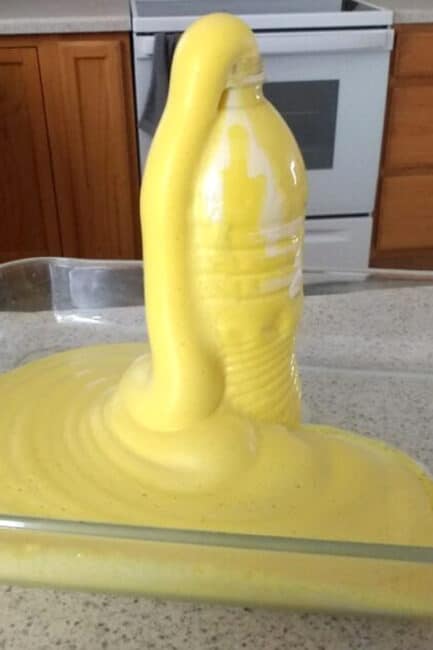
Get the FREE Week of Science Experiments
My daughters and I have done a lot of science experiments over the years. There are so many to choose from!
We’ve tried color-changing milk , learned about what dissolves in water , and experimented with density in liquids . Just to name a few.
Recently, I was in the mood to do a science experiment and asked my daughters which one they would like to do again.
I was (pleasantly) surprised they both said the same experiment: elephant toothpaste.
Not only did they both agree, but I already had all of the supplies on hand!
Make Elephant Toothpaste Experiment: Supplies Needed
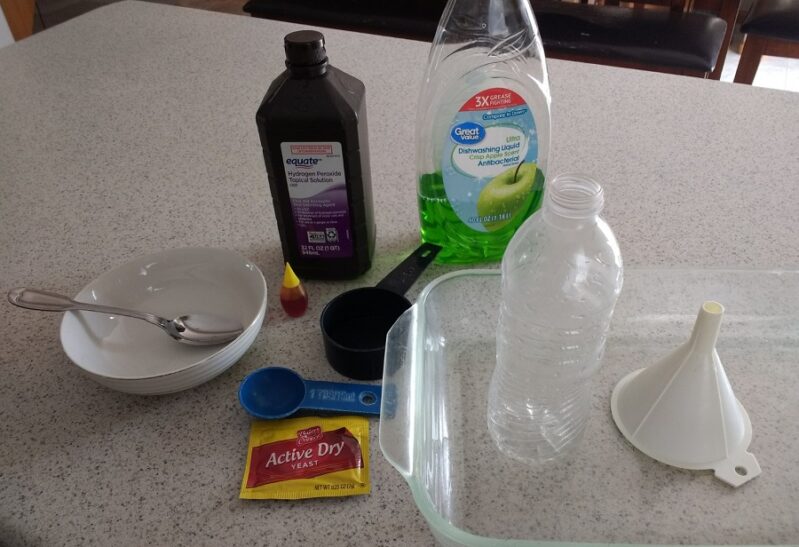
Elephant toothpaste recipe ingredients:
- yeast packet (0.25 oz)
- 1/2 c. 3% hydrogen peroxide
- 3 Tbsp warm water
- food coloring
- 1/2 c measuring cup
- empty water bottle
- measuring spoon (1 Tbsp)
- small spoon
- safety glasses
How to Make Elephant Toothpaste Experiment for Kids
Once you have gathered all your supplies, you can follow the steps below. Which preschoolers can even assist with.
Place the empty water bottle in the cake pan. Put on safety glasses.
Hypothesize what will happen when you mix the ingredients together.
First pour 1/2 cup hydrogen peroxide into the empty bottle using a funnel.
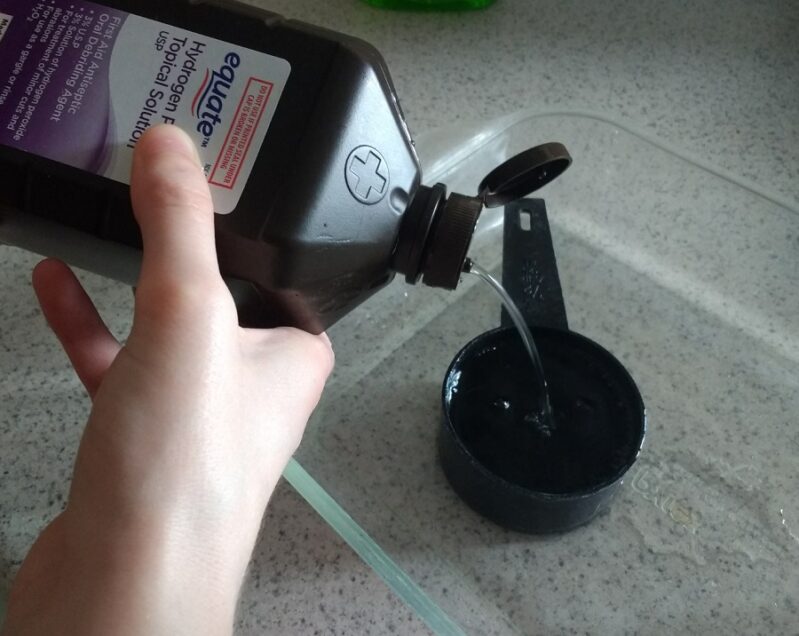
Get the FREE Science Experiments Download
Then squirt a small amount (about 1 Tbsp) of dish soap into the bottle.
Gently swirl the bottle to mix contents.
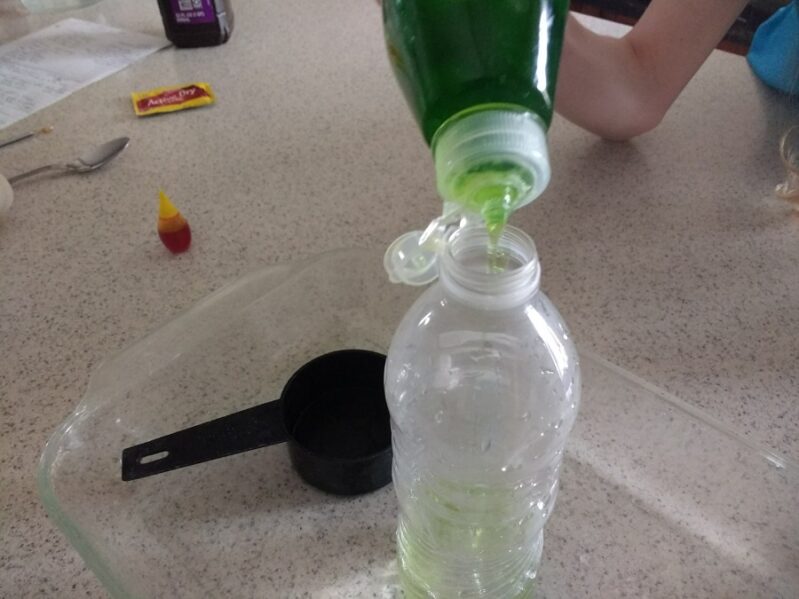
Then you can add some drops of food coloring. The more drops you add, the darker the color will be.
Gently swirl the bottle again to mix the contents.
We added yellow food coloring.
The kids hypothesized the yellow food coloring mixed with the green dish soap would create blue elephant toothpaste.
It didn’t. It was still yellow!
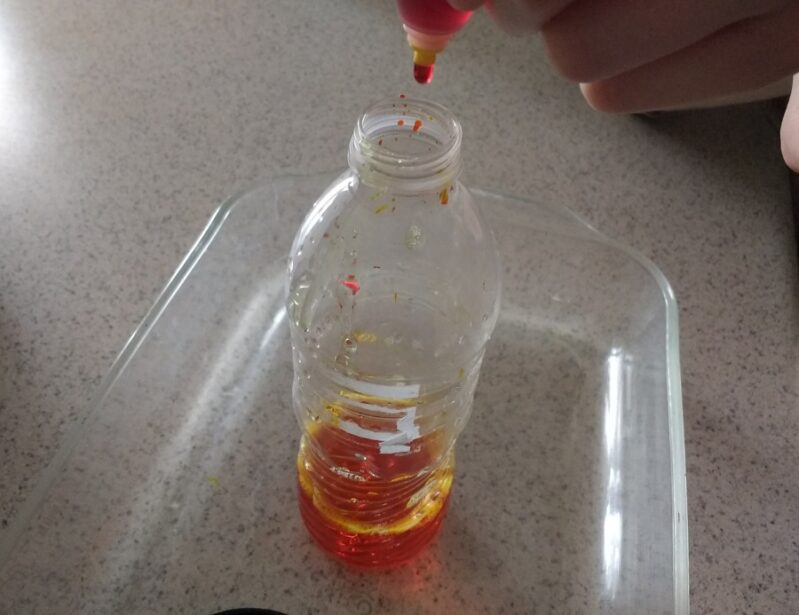
Next empty the yeast packet into a small bowl.
And then add 3 Tbsps of warm water.
Now mix with a spoon until the yeast is completely dissolved. (My daughter said it looked like chocolate milk when it was ready.)
Your almost ready now to watch the elephant toothpaste for kids in action!
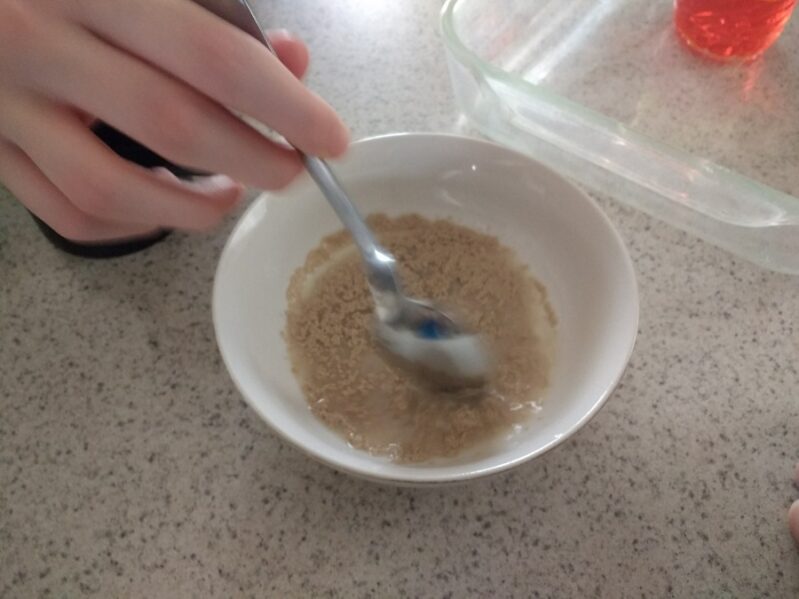
Combine Everything!
Lastly, dump all the contents from the bowl into the bottle using the funnel. Remove the funnel quickly.
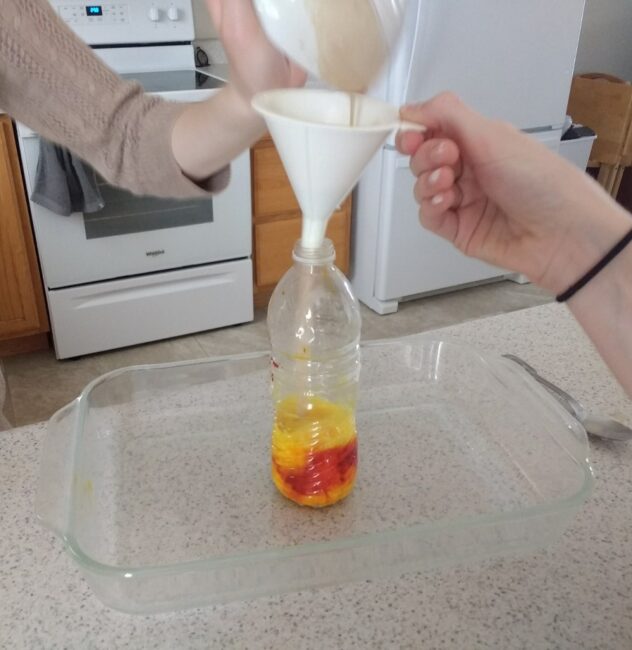
Observe & Explore the Elephant Toothpaste with your Kids
Foam and bubbles should ooze out of the water bottle.
Feel the side of the bottle.
It should feel warm because heat is created. (Do not attempt to put any of it in your mouth.)

Did what you had predicted happen?
Clean up by pouring the foam down a sink with some water.
Download the Elephant Toothpaste Experiment for Kids Free Printable
It is convenient to have a science experiment in an easy-to-follow print-ready format.
So, below is an easy-to-read file with supplies and directions to make your own elephant toothpaste for kids.
Download and enjoy!
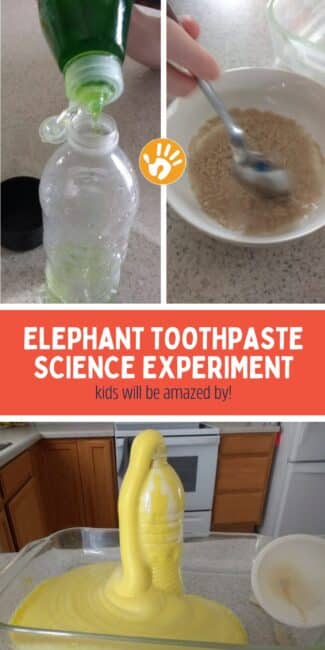
What is the Scientific Method ?
My daughters fill out lab reports when we do science experiments for school.
But this science experiment was just for fun. No lab reports required!
With that being said, we still seemed to follow (at least most of) the scientific method.
- Hypothesize
I did some online research with the kids to explain what had happened with the elephant toothpaste.
There were quite a few technical terms we discovered including “exothermic reaction” and “catalysts”.
Feel free to do your own research for more information.
In simplest terms, however, we learned the bubbles that were created contain oxygen. (They knew oxygen is something in the air we breathe.)
The dish soap helped to make the foam.
And the yeast helped to make the bubbles and foam form faster.
We absolutely loved the elephant toothpaste science experiment for kids! We hope you do too.
What is your favorite science experiment?
Share with us in the comments!
WANT TO SAVE THIS ACTIVITY?
Enter your email below & we'll send it straight to your inbox so you can access this activity later! Plus, you'll get simple activities from us every week!
- This field is hidden when viewing the form Activity URL
- This field is hidden when viewing the form Activity Title
- Phone This field is for validation purposes and should be left unchanged.
About Brigitte Brulz
Brigitte Brulz is a homeschooling mom of two daughters, wife of her high school sweetheart, and author of Jobs of a Preschooler and Pickles, Pickles, I Like Pickles. She offers free coloring pages and activity ideas on her website at BrigitteBrulz.com .
More Hands on Kids Activities to Try
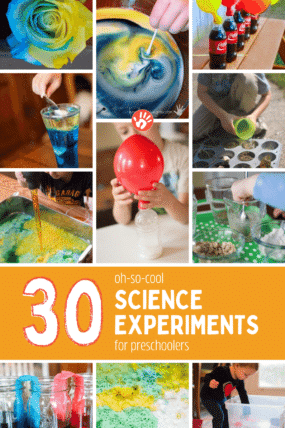
Reader Interactions
11 comments.
peter dufield says
August 4, 2022 at 5:53 am
great really good, but adverts got in way
Leave a Comment Cancel reply
Your email address will not be published. Required fields are marked *
This site uses Akismet to reduce spam. Learn how your comment data is processed .

What Parents Have to Say…
- Hands On As We Grow Newsletter "It is hard to think of things to keep the 3 year old entertained and engaged while taking care of the baby. Everything we have tried so far from your website, the three year old has loved. Your ideas are so simple and he can do them for hours. HEAVEN!" - Karen I.
- I am now one happy Dad! "You have changed how I spend time with my kid in so many positive ways! I am now one happy dad that no longer wonders what I am going to do with this little guy for the next 12 hours :P Your site was this first time dad life saver!" - Jack C.
- Hands On As We Grow Newsletter "I feel like a new mama having so many fun ideas. I used to dread the afternoon, after naps, as it was so boring doing the same thing day after day but now I look forward to our "play" time!" - Haley S.
- Free Activity Challenge "Thank you so much for these activities. They have proven to me that I CAN be that mom that does cool and creative things with her kids! And those cool and creative things can actually be quite simple! What a revelation. Thank you!!" - Katie M.
- Activity Plans eBooks "This takes down the need to scour the internet for ideas. It's like looking for a recipe on the internet, so many options that often times it is less overwhelming to look in a book on the shelf than stress about too many options." Robyn G
- So organized and easy to use. I have found it impossible to Google ideas from a million different sites, get organized, shop for supplies, etc. This is exactly what I have been searching for! Thanks for making something so organized and easy to use. - Early Years Activity Plans User, Melissa C.
- The Activity Room Member "I absolutely love that this takes all the prep work out of engaging my children. It is so easy to just put up the calendar, and glance at it for inspiration when we are in a funk." - Rachel
- Grateful to have activities handed to us... "There's always something new for us to discover, as well as old favorites. I am so grateful to have activities handed to us... Fun and easy ones that can be put together in a moment's notice! You're awesome Jamie and I appreciate you sharing your activities and ideas!!" - Melissa C.
Shop eBooks of Activities

Get activity plans delivered to your inbox, every week!
Activities that hands-on parents absolutely love.

30+ Scavenger Hunt Ideas for Kids To Do at Any Age
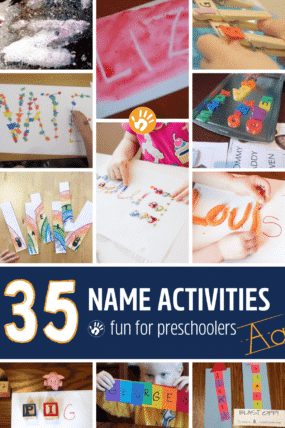
35 Name Activities For Preschoolers
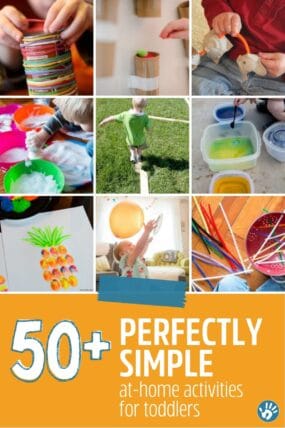
50+ Simple Activities for Toddlers
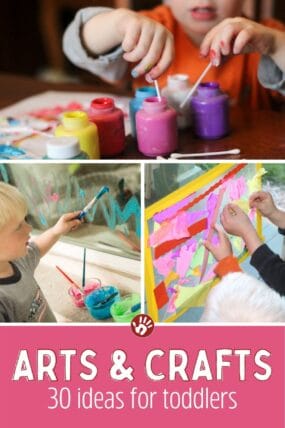
What Toddler Crafts & Art Projects Can We Do? 30 Ideas
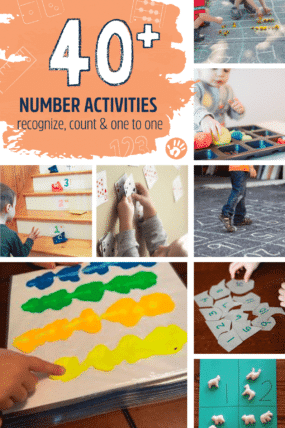
40+ Awesome Number Activities for Preschoolers
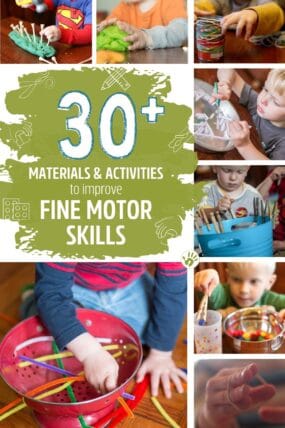
Improve Kids Fine Motor Skills with 30 Materials & Activities
Get started having fun with your kids.
PLAN THE FUN WITH THE FREE KIDS ACTIVITIES PLANNER! AND RECEIVE ACTIVITIES EVERY WEEK!
- Preschoolers
- Kindergartners
- Grade School
- Literacy & ABCs
- Math & 123s
- Art Projects
- Gross Motor
- Shop Activity Plans
- Member Login
Elephant toothpaste
If an elephant used toothpaste, this is probably what it'd look like! Learn about chemical reactions by watching this heat-producing mixture bubble and overflow for up to half an hour. The experiment comes from pages of the Nat Geo Kids book Try This! Extreme .
DON'T FORGET YOUR SAFETY EQUIPMENT: safety goggles, lab apron, nitrile gloves
Stand the soda bottle in a pan.
Insert funnel in neck of soda bottle.
Add ½ cup peroxide, detergent, and food coloring.
UM, DID YOU SEE THE WARNING ABOVE? Check it out again!
In measuring cup, beaker, or plastic cup, combine yeast and warm water. Combine with plastic spoon.
Pour yeast mixture into soda bottle and remove funnel.
WARNING: In case you missed it the first time, avoid touching or getting the chemicals on skin or clothing. And don't get too close, as heat and steam can be dangerous.
WHAT'S GOING ON
Hydrogen peroxide normally decomposes (breaks down into separate elements), and combining it with detergent and yeast (a catalyst) speeds up the process.
As the oxygen emanates from the reaction, it creates bubbles. The detergent speeds up the foaming. The reaction is "exothermic," meaning it produces heat as well as steam.
WARNING: This experiment uses chemicals that can irritate skin and damage clothes, so make sure to use safety goggles, lab apron, and nitrile gloves. Avoid touching or getting the chemicals on skin or clothing. And don't get too close, as heat and steam can be dangerous.
Science Lab
(ad) try this extreme: 50 fun & safe experiments for the mad scientist in you, (ad) make this: building thinking, and tinkering projects for the amazing maker in you, (ad) try this: 50 fun experiments for the mad scientist in you.
- Terms of Use
- Privacy Policy
- Your California Privacy Rights
- Children's Online Privacy Policy
- Interest-Based Ads
- About Nielsen Measurement
- Do Not Sell My Info
- National Geographic
- National Geographic Education
- Shop Nat Geo
- Customer Service
- Manage Your Subscription
Copyright © 1996-2015 National Geographic Society Copyright © 2015-2024 National Geographic Partners, LLC. All rights reserved

IMAGES